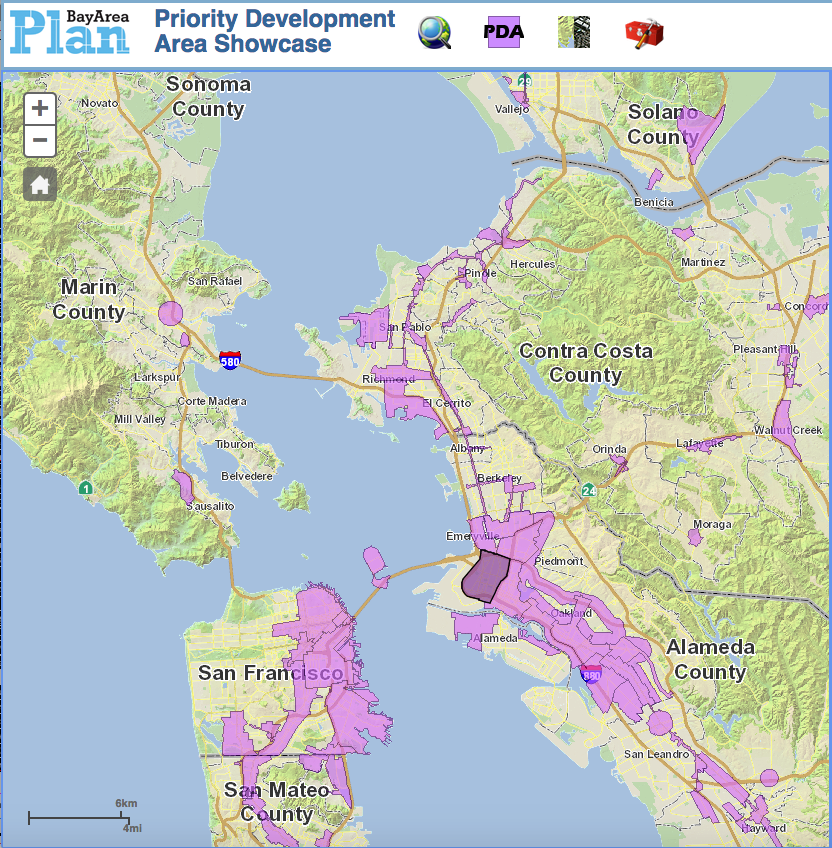By Matt Williams
 Back in 1986, the Sierra Club’s national Board of Directors adopted a policy on the urban environment that guides our work in the Bay Area to this day. The policy stipulated that “urban areas, which consume the majority of our resources, [should] be highly efficient and non-polluting so as to minimize our impacts upon this planet's resources and environment.” The policy also noted that “since the physical state of a city reflects the well-being of its people,” urban environments should be “healthy and stimulating.”
Back in 1986, the Sierra Club’s national Board of Directors adopted a policy on the urban environment that guides our work in the Bay Area to this day. The policy stipulated that “urban areas, which consume the majority of our resources, [should] be highly efficient and non-polluting so as to minimize our impacts upon this planet's resources and environment.” The policy also noted that “since the physical state of a city reflects the well-being of its people,” urban environments should be “healthy and stimulating.”
Today, our challenge in the Bay Area is to meet the housing demands of a rapidly growing population while also protecting the environment and preserving the quality of urban life. These days we know that protecting our environment entails not only preserving our remaining open spaces and fighting for clean air, water, and land, but also limiting greenhouse gas emissions that cause climate disruption.
The Sierra Club believes we can protect the environment and fully meet our housing needs while maintaining urban environments that are equitable, healthy, and stimulating. To achieve this vision, the Sierra Club supports planning policies that are right out of the Club’s 1986 policy: we advocate for compact infill development in urban areas, while simultaneously opposing sprawl development that puts pressure on our open spaces and increases climate-warming emissions.
A key mechanism for achieving this vision is the Bay Area’s Sustainable Communities Strategy (SCS). So what is the SCS? The Bay Area’s two main regional planning agencies, the Association of Bay Area Governments (ABAG) and the Metropolitan Transportation Commission (MTC), set it out in the 2013 Regional Transportation Plan, called “Plan Bay Area”:
"[Senate Bill 375] requires each of the state’s 18 metropolitan areas — including the Bay Area — to reduce greenhouse gas emissions from cars and light trucks. Signed by former Gov. Arnold Schwarzenegger, the law requires that the Sustainable Communities Strategy (SCS) promote compact, mixed-use commercial and residential development. To meet the goals of SB 375, Plan Bay Area directs more future development in [Priority Development Areas] that are or will be walkable and bikable and close to public transit, jobs, schools, shopping, parks, recreation and other amenities."
On its website, ABAG notes that Priority Development Areas (PDAs) “are the foundation for sustainable regional growth.” There are 98 PDAs in the four counties comprising the Bay Chapter — 45 in Alameda, 39 in Contra Costa, two in Marin, and 12 in San Francisco. ABAG has posted a map of each of the PDAs in the Bay Area online here.
Through 2040, approximately 77% of the expected two million new residents in the nine Bay Area counties are expected to live in PDAs.
As a part of a legal settlement with the Sierra Club and Communities for a Better Environment, ABAG and MTC have made public lots of useful information about each PDA that we can use to track our region’s progress toward sustainable growth. Unfortunately, the news isn’t all good. Here’s some of what we’ve learned:
- A PDA has to have a minimum level of mass transit service, but we know that 15 of Contra Costa County’s 39 PDAs do not have adequate transit service.
- In the two-year period from 2013 to 2014 (the latest period for which we have information on housing units built), only 18 of Alameda County’s 45 PDAs added any affordable housing units.
- In 2015, Contra Costa County issued 240 permits to build very-low, low, and moderate-income housing (that figure is not limited to PDAs, but is still useful). There is a state-required target of 11,846 permits for the three income categories, combined, over an eight-year period (2015 is the first year). At the 2015 rate, it will take Contra Costa 49 years to meet the eight-year target.
The lack of progress on making most PDAs succeed through decent transit and affordable housing is clear.
WhatYouCanDo
The Bay Chapter has launched a new effort to point out the facts to each city with a PDA and to advocate for things to get moving in the right direction as soon as possible. Chapter volunteer leaders will be meeting with city council members to review the situation and press for action. If you want to get involved in this work, email the chair of the Bay Chapter’s Transportation & Compact Growth Committee, Matt Williams, at mwillia@mac.com.